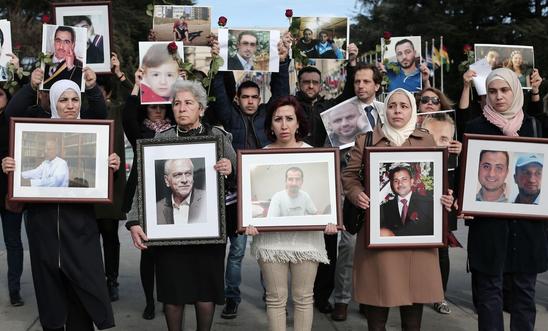 |
| Image source: @FamiliesSyria on Twitter |
On October 11th, the Families for Freedom bus began its journey in London. The iconic double-decker, covered in photographs of Syrians who have been illegally detained, disappeared, and even murdered by the Assad regime, carries the families of these detainees, mostly (but not only) women, in a journey across Europe to call for the release, at the very least for information, of their loved ones. Their next stops will be Paris and Berlin, "wherever peace talks are being held", as their website states.
Their final destination, as the bus so proudly announces above the windshield, is Damascus. To "pick up" their loved ones. The sheer hope in that sign—it blows my mind.
And that's why I decided to use it for my WATWB post this month.
There are few things as hopeless as having someone you care about vanish into a corrupt, totalitarian system. In Latin America we're well versed in the subject—and we know, first-hand, how unfathomable that particular black hole is. We know, also, how distant any possibility of hope seems. And we know, all too well, the excruciating pain hope can bring when it comes any closer.
And that's why I decided to use it for my WATWB post this month.
There are few things as hopeless as having someone you care about vanish into a corrupt, totalitarian system. In Latin America we're well versed in the subject—and we know, first-hand, how unfathomable that particular black hole is. We know, also, how distant any possibility of hope seems. And we know, all too well, the excruciating pain hope can bring when it comes any closer.
 |
| Image source: Amnesty.org.uk |
And yet here they are, these women. Against all odds. Against the whole world. Holding their heads high. Holding on to a ragged shred of hope as tattered and worn as the once-favorite blankie of a grandchild long grown and gone.
We are women-led. We are peaceful. We are determined.
Can you imagine the courage that must take? I try, but I fail. It's staggering, isn't it? And that's why I find it so inspiring: if they can do it, if they can—after years of not knowing, of being turned away, of being silenced and threatened and ignored—still find a way to hold on to hope, then we all can. No matter the odds. No matter how impossible the goal may seem. No matter how many times you've failed. No matter who stands in your way, who tries to drown out your voice. No matter what.
Hopelessness is, quite simply, not an option. And the impossible, as they say, just takes a little bit longer.
Hopelessness is, quite simply, not an option. And the impossible, as they say, just takes a little bit longer.
This post is part of the We Are the World Blogfest, a monthly event created by Damyanti Biswas and Belinda Witzenhausen to spotlight stories of hope and light. This month I'm helping Belinda out as a co-host, along with extraordinary bloggers Shilpa Garg, Sylvia McGrath, and Mary Giese—please hop over to check out their WATWB posts when you get a chance; they're always amazing. And take a peek at the other WATWB participants for a dose of feel-good to last you a whole month. You'll be happy you did :)
Thank you so much for the visit!



